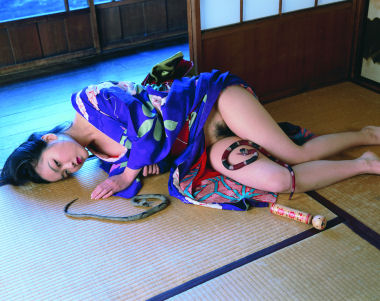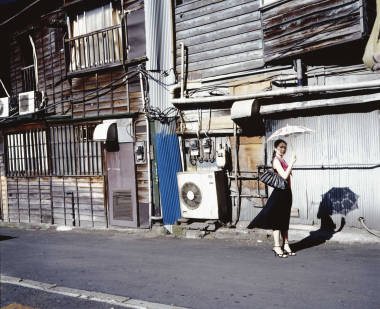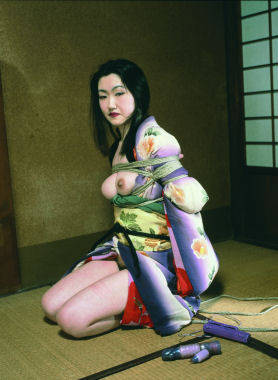 |
| Nobuyoshi Araki: From A’s paradise, 1999; © courtesy the artist / Barbican Gallery |
Araki: self.life.death is the title of the Barbican Gallery’s current Nobuyoshi Araki exhibition. It comprises over four thousand images that showcase the artist’s idiosyncratic observation of people, places and things.
The exhibition opens with From the blue period, 2005, nine enlarged photographs hung three by three. The pivotal work depicts a bound geisha lying on a wooden floor, kimono ripped and around her shoulders. Her body is contorted; as her breasts and torso face the viewer her head turns away, towards the open window and trees outside. The clothes are ruffled; there are signs of attack and yet she lies perfectly still, alone in the frame. This pseudo-violent scene is obviously staged. The images are treated to appear aged and are tinted with a pale blue wash – seemingly submerged, the sequence is dreamlike, detached and utterly erotic. This is Araki at his best.
 |
| Nobuyoshi Araki: Kaori, 2004; © courtesy the artist / Barbican Gallery |
From last summer, 2005, is a series of twelve photographs from Tokyo city life, more vibrant but less impressive than the above. They are overlaid with a dilute acrylic paint in different bold shades. It seems that paint on the photograph, rather than the subject matter itself, is Araki’s most recent adventure.
 |
| Nobuyoshi from Kinbaku series, c.2000; © courtesy the artist / Barbican Gallery |
The third series shown is darker than the first two. Colour – eros, 2005, comprises sixty black-and-white photographs of female figures bound and splayed in dramatically lit compositions. The women stare into space or sometimes at the photographer, without pain or lust – apathetic.
From this we are led to a collection of Araki’s earlier work. Tucked into the corner of the main exhibition space lies a smaller room, all three walls covered in polaroids taken by Araki in the last twenty years, during a period in Japan where censorship prohibited photographs of what he likes best. Images of naked women are spliced into others; a leaking egg yolk, a long piece of red meat, flowers, cloud formations captured after his wife’s death. The nudes are usually bound neatly in ropes, a process called ‘kinbaku’ from the Edo period, first used with criminals and then with beautiful women. This historical reference is both Araki’s emblem and refuge, a means of heightening eroticism.
 |
| Nobuyoshi Araki : From In ruins, early 1997; © courtesy the artist / Barbican Gallery |
Further along we see twelve of his large Tokyo cityscapes (c 1998), some inhabited. The city is busy but the atmosphere is calm. Laden with innuendo, a skyscraper is framed by the V shape of two diverging elevated roads. Other photos contain numerous telegraph wires running through and around the city. Even Tokyo is bound.
Next we see flowers (all c 1997), magnified and isolated, mainly in colour. Some flowers have been painted upon, some remain unadulterated. An orchid resembles a pelvis, the pink blossom of which sits evocatively at the centre. It is inescapable and penetrating. In turning everything and everyone into sex, Araki turns sex into all of these things, he controls our perspective. His sexuality is omnipotent; for him it is a visual framework rather than the physical trap it seems for Paul McCarthy.
It becomes apparent that the curatorial approach to this exhibition is neither chronological nor thematic, but rather a medley of both. The ground floor shows a large and satisfying body of mainly new work; the space upstairs divides into eight series, from his graduation in 1963 through to the 1990s. The viewing of his life and progress in reverse is frustrating at times, and by showcasing the constant repetition in his subject matter and theme the argument for his artistic strength is somewhat weakened. Food was a room that showed two series of said title (1993 and 2001) and displayed some uncharacteristically weak work. The curatorial team’s wealth of exhibition space combined with their voracious appetite for Araki seemed at this point detrimental to the exhibition’s promising beginnings.
Additionally, some of the explanatory texts are in conflict with the work itself. Yoko, 1991, is a series of works based on his wife – who died the same year – from the time they were married and later during her terminal illness. The majority of these works feel staged, and indeed we learn that they are the prototypes for his later dramatic works. They failed to reveal any details of his wife, himself or their relationship together. The texts, however, suggest that these works disclose Araki’s emotional engagement, an assertion at odds with the distance he maintains from all of his subjects in order to achieve the compositional tension. These texts also speak of the “truths" that Araki found in the eyes of the nude bound women at the moment a photograph was taken. In contrast, I find their expressions restrained, apathetic, and indeed stronger for being so.
While viewing, I overheard three different men (triumphantly) refer to Araki as “a dirty old man." I am inclined to agree, although you cannot help but enjoy his eroticism, amongst other things.
Isobel Harbison is a freelance writer and curator based in London and is currently working on Channel 4’s Big art project .